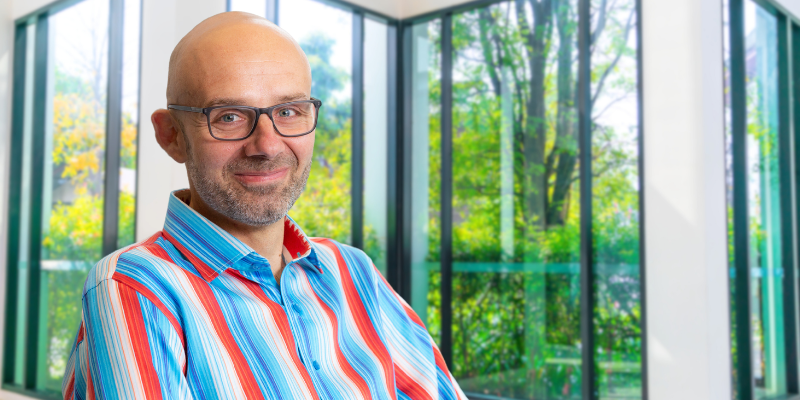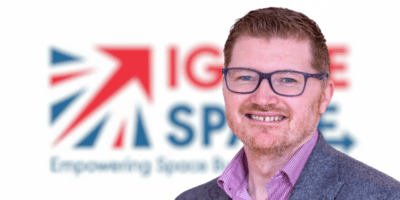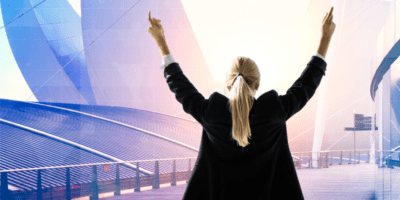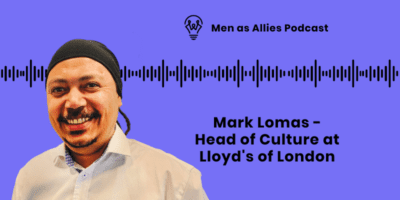Andy Boothman is a designer with a passion for brand building and development who runs the brand and marketing agency, Busy as AB. Andy is also the founder of DressCode, a fashion-tech start-up that helps people communicate their passions, be their best selves, expressing their character with style and innovative designs featuring binary, Python, screen glitches, cursors, pixels, DNA, algorithms, and even space invaders. He is a passionate champion of inclusion for all underrepresented groups, alongside being the father of a ten-year-old STEM-loving daughter.
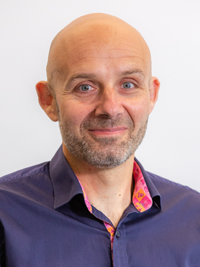
“I’ve enjoyed working for many female leaders during my career and I’ve never perceived it as being ‘a thing’. We’ve all seen how people can be put into boxes and stereotyped but I’ve always tried to make sure I wasn’t doing that myself. I try to value everyone for the person and individual they really are.”
Proving them wrong
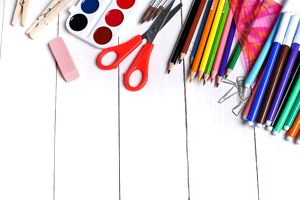
At school, I was very interested in art. I did have good academic ability but art was my passion. It was the thing that really got me engaged and was something I wanted to follow, but that didn’t go down particularly well with most of my teachers. They didn’t believe there was any future in it and we had some very direct conversations of that nature where they said: “We believe that this is a cop-out. We don’t think this is the right future for you.”
If anything, that made me more determined to prove them wrong. So, I did a foundation course. I would highly recommend it to anybody who’s considering the creative industries as it’s a wonderful way to get 12 month’s experience across a broad range of areas, and it really opens your mind to the possibilities of what is available out there.
From there, I did my degree and I was lucky enough at the end of my degree that there were some agencies circling, looking to take on new talent. I think I was the sixth person interviewed and the first person offered a job. So, it felt like wow, amazing, away we go!
Learning how NOT to run a business
Whilst I really enjoyed my early career working in agencies I saw a lot of toxic office culture, which was also quite insightful and a different type of learning that I hadn’t quite envisaged. Seeing those poor behaviours didn’t sit particularly comfortably with me, so I sought out people who were on the same page, who wanted to spend one-to-one time with customers and develop professional relationships using very human values. (And cut out a lot of the crap that sits in the middle, if I’m being totally honest.)
We set up our own agency, BakerBoothmanEdy and grew that over 10 years. Then in 2013, my daughter arrived. I was working in a busy office and technology was really stepping up a pace, I could see the possibility of taking things virtual and reducing our overheads. A virtual agency felt like a viable option so I spoke with a few people in the team and the rest is history.
Going virtual
We set up Busy as AB in 2014 as a virtual agency. We’re now nearly ten years in and there’s never been a point where it’s been a problem – being virtual – and not having an office. It’s given everybody a much better work-life balance.
In 2018, on the back of the success of Busy as AB, I decided it was time to start to challenge myself again and set up another business, DressCode Shirts. It was exciting to embark on this journey but, understandably, for most client work, we’re (Busy as AB) working under NDAs [non-disclosure agreements] so we can’t talk about it. Surprise, surprise — lots of clients don’t want their competition to know who’s doing their work, an who can blame them?
I realised that if we had our own brand, we could talk about everything we were doing, and it was also an active case study for what we do. For me, it’s also a great learning opportunity and a chance to follow a passion that goes back to my foundation course days, which included fashion, textiles and everything that goes with it.
With the environmental concerns we all have today we thought about how we could build a sustainable business that could champion some of those processes that are available but haven’t been maximised to their true potential.
I set about researching, looking around, thinking: “What type of business should this be?” Over the years I’d worked in tech, worked in hospitality, done food, retail, quite a lot of different things in my agency background, I was looking around, trying a few things out, kicking things around.
Getting switched on to fashion-tech
From a personal perspective, and the time I’d spent with tech businesses, people really switched on and engaged with the tech, and they were really passionate about it, but yet when it came to communicating out in the clothes that they were wearing, they would often just wear these awful t-shirts with a big slogan written across them.
Maybe that would be OK if you were in the office, but when you’re going out visiting clients or presenting and you want something that’s still going to feel like it’s an expression of you and what you’re passionate about, you can’t really rock up in that type of t-shirt and expect to be taken seriously.
We did a lot of research to see if there was anybody creating a solution and there wasn’t. I thought: “Right. Here’s a big group of people who are underserved and underrepresented. What can we do to communicate the things that they’re passionate about in their clothes?”
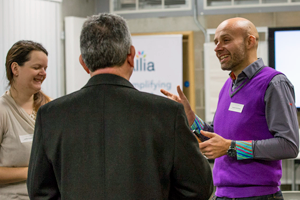
Introducing CashCuff™
DressCode has been a wonderful journey, and through it we developed wearable tech, because you can’t really have tech printed on the shirts and not have wearable tech in them, because we’re talking to techies at the end of the day! We did the first ever payment shirt, with contactless payment in the clothing, and called it CashCuff™.
It is a standalone system in the sense that once you put the money on it, it will run itself. You can check your balances and things like that later through computers or phones, but essentially you were good to go with the clothes you had on, so it is incredibly subtle and very secure because no one would know that you’re carrying a means of payment as there’s no outward sign. COVID accelerated the acceptance of contactless exponentially, so that was one welcome byproduct of an otherwise awful time.
These days CashCuff™ is part of a larger ecosystem, something we call ‘Digits’ that brings access control, documentation, passes and tickets into the clothes that you’re wearing. These features and services are real enablers for some groups of people, it’s an extension of ‘enclothed cognition’, where the tech within the clothes, really enhances the wearers sense of well-being.
Sustainability built-in
Throughout COVID one of the things we were working on was a project with the British Antarctic Survey to develop shirts for their team at COP26. This was an absolutely fantastic opportunity, to work with a great team, communicating something that is so important and for such a prestigious event as well.
We managed to do a lot of research (despite the challenges of lockdowns) and find materials that are wood-pulp-based, made using an award-winning process. It felt good to be doing something like that and to show other people that it could be done too. We’re a small producer, so if we can do it, then others certainly can, that in itself has created momentum around DressCode.
The sustainability side of the business continues to grow and evolve, we’re part of an ongoing project called #ShowYourStripes, run by Professor Ed Hawkins MBE and his wife, Dr Sam Burgess, to highlight the progressive warming of the planet in a single, striking image. The momentum behind this is fantastic, the graphic is appearing in more places and it is just wonderful to be contributing to this. It fills me with hope for the future.
Welcome to #ShowYourStripes day. Here’s some background to the shirt 👔 💙🤍❤️🌎#ShowYourStripesDay #dresscodeshirts #ClimateCode pic.twitter.com/66WS89vlnq
— dresscode (@dresscodeshirts) June 21, 2022
We also have our Recode service, which is for people who’ve got existing shirts they may want to update. Or we’ve got other customers who collect material on their travels or have got shirts that are particularly important to them from times gone by. It could be the shirt they got married in or it’s a memory from school or something like that. We can take sections of these existing shirts and work them into new designs.
This takes enclothed cognition to a new level, when you start the ReCode process for somebody, you’re bringing memories into the garment as well as design, that is incredibly powerful and the whole journey we take with people, it is a lovely thing to be part of as you get to understand why it’s important to them.
It’s also about where we can work other subtle, often very personal details within the garment. The things I particularly love are the hidden things, which we tend to put inside cuffs and collars, as well as incorporating buttons with a specific interest.
Appreciating the whole person
I’m from an arts background, I think there’s never been a broader collection of more neurodivergent people than those found within arts and design. I’ve worked with many different people doing lots of different things, and I’ve seen people marginalised for no good reason over the years.
Very early on in my career I found that quite hard to observe. You’re just starting out and you don’t feel like you’ve got a voice or you’re able to take a stand. I observed and decided that these were practices I didn’t like and I didn’t want to be part of the work I do.
I’d love to think that we’re becoming more aware nowadays. I’m an optimist, hoping people’s consciousness is expanding globally through the Internet and social media. We are much more accepting of the subtle differences we all have that make us who we are.
These are the subtle differences that also mean people have some amazing talents, but those amazing talents come as a package. You don’t just get one bit. You have to appreciate the whole person and support that person in whichever way they need.
One of the beauties of us being virtual means that people can keep their own hours. I’ve got some people who love to work through the night, and that’s completely their choice if they don’t want to keep a nine to five.
More than anything, for me it’s just about being human and keeping the lines of communication open so that anybody feels confident enough to say: “I’m struggling with this” or “Can I get some help here?” Then we can explore what we need to adjust, how we can reshape bits and pieces so that we can get that happy fit. It’s a constant evolution, constant chat backwards and forwards and I try to keep it as casual as possible because you don’t want to make these things bigger than they need to be.
The general levels of awareness are getting better, especially around things like neurodiversity. When you speak with younger people who are fresher out of the education system, they are very aware of every aspect of their personality. There are so many ‘older’ people who went through the education system at a time when no one talked about any form of mental health, it was all brushed under the carpet.
It’s no wonder that you’ve got so many people who are anything from 30 upwards suddenly being diagnosed with loads of neurodivergent tendencies and traits, things that have always been there. It’s not like they just suddenly materialised, but now I’d like to think there’s a bit more understanding, acceptance and support.
Being an ally for girls and women
I’ve worked with some fantastic people throughout my career. Personally, I’ve never really perceived gender as an issue. I’m more interested in what someone’s bringing to the table, their skills and their enthusiasm, but I have seen it happen and you just think to yourself: “Why?”
I suppose the root of it is questioning ‘why’ and saying it shouldn’t be like that, particularly for the next generation. For my daughter we’ve worked hard to make sure that there’s everything on the table, so when it comes to sports, why does it have to be a sport that’s traditionally considered to be female? Why does it have to be a sport that’s traditionally considered to be male? There’s no good reason for that.

She’s young and able to adapt. We’ve translated that thinking into STEM activities as well because there’s so much exciting and cool stuff you can do within this space. Things that really capture their imagination and allow them to explore so many things.
Looking back at my education, I feel it was all quite stale. I’m talking late-eighties, early nineties and there wasn’t a great deal of creativity put into the way subjects were delivered. It was very textbook: These are the facts. You’re going to regurgitate them. We’re going to put you in this hole, and that’s the trajectory.
Whereas now, I’d like to think things are a lot more fluid. In my eyes, it is going to be about doing different things at different times, and how we can inspire them. That whole exposure to different things is vital so that you don’t get boxed in.
I’ve enjoyed working for many female leaders during my career and I’ve never perceived it as being ‘a thing’. We’ve all seen how people can be put into boxes and stereotyped but I’ve always tried to make sure I wasn’t doing that myself. I try to value everyone for the person and individual they are really are.
We’re humans and we crave change, but then the second it starts to happen, we’re like: “Oh no! We want this to stay exactly as it was before. We’ll just put it back to how it was.” It’s weird because we seem to crave the change but then the second it starts to happen, we’re like “No, stamp it out!”, which is a real shame.
It should be a constant evolution and constant learning. I’ve been fortunate in my career to have those opportunities — to be challenged and, also challenging myself, constantly moving forward.
Partnership
I am married to Anne-Marie. She’s a geneticist, working as a director for a global pharmaceutical business. We have a young family and were determined to spread the load that comes with that across the two of us equally. We both have professional aspirations and we both wanted to ensure that we built close personal bonds with our children. I’m not going to pretend that this is easy for either of us, it requires a lot of planning and organisation, but it’s so worth it.
It’s a wonderful thing to be able to support the woman that I love in both her professional career and within our relationship, allowing us both to build great bonds with our children. It’s brought new skills and challenges to both of us, it’s also made is stronger as a team and it’s great to support one another.
I am super proud of her, within the world of pharma there is still a very strong male dominance within the senior management roles, Anne-Marie is really dedicated to her job, she leads a team developing cancer treatments and is now part of the ‘women in leadership’ programme within the organisation.
Coming up
Outside work, this weekend I am going with my daughter to Ford’s site at Dunton in North London to watch her take part in an electric go-kart building and racing competition, they’re doing for the whole day on Saturday. I think that’ll just be a fantastic experience for her — there’s so many things that will come out of that, from the social side of things through to the learning, the design, the teamwork.
I’m really looking forward to it, even though I’m just going to be a casual observer. I can’t wait to see what the impact is for her, so that’ll be exciting. It’s a national programme. There’s the one at Ford this weekend and there’s one at Goodwood Festival of Speed in two weekend’s time.
The STEM lead at the school is a female engineer, which is just wonderful. She said we’ll get quite a breadth of people from all parts of the automotive and engineering sector attending the events because they’re genuinely interested in giving something back to the next generation. I’m secretly quite jealous because if these activities had existed when I was a child, I would’ve been in seventh heaven.
On the business side, DressCode will be five years old in September, so we’re putting the finishing touches to a few bits and pieces to mark that milestone. We’ll be reflecting back on what we’ve achieved, what we’ve learned, and most importantly, how to shape the next few years of the business from that experience.
Header image background: Image by jannoon028 on Freepik

